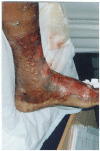Terrestrial snakebites in the South East of the Arabian Peninsula: patient characteristics, clinical presentations, and management
- PMID: 21931788
- PMCID: PMC3171447
- DOI: 10.1371/journal.pone.0024637
Terrestrial snakebites in the South East of the Arabian Peninsula: patient characteristics, clinical presentations, and management
Abstract
Background: To describe the characteristics, clinical presentations, management and complications of snakebites in the border region between Al-Ain, United Arab Emirates (UAE) and Buraimi, Sultanate of Oman.
Methodology/principal findings: We carried out a retrospective review of medical records to study snakebite cases over four-year duration at three tertiary hospitals. Overall, 64 snakebite cases were studied with median hospitalization of 2 (interquartile range [IQR] 1-4) days. The majority of cases were male (87.5%), and most (61%) of the incidents occurred during summer months. The bite sites were predominantly (95%) to the feet and hands. Main clinical features included pain, local swelling, and coagulopathy, blistering and skin peeling. Overall, there were no deaths, but few major complications occurred; extensive skin peeling (n = 5, 8%), multi-organ failure (n = 1, 1.5%), and compartment syndrome (n = 1, 1.5%). Polyvalent anti snake venom (ASV), analgesia, tetanus toxoid, intravenous fluids, and antibiotics such as ampicillin, cloxacillin, and cephalosporins were commonly instituted as part of treatment protocols in the three hospitals.
Conclusion: The overwhelming majority of bites occurred during summer months, and envenomations were more common in, relatively, young male farmers, but with no serious clinical complications. Prevention and treatment strategies should include increasing public awareness, developing management guidelines, and manufacturing specific ASV for a wide spectrum of the local venomous snakes.
Conflict of interest statement
Figures
References
-
- World Health Organization. Rabies and envenomings. A neglected public health issue: Report of a consultative meeting. Geneva: WHO; 2007. Available: http://www.who.int/bloodproducts/animal_sera/Rabies.pdf.
-
- Ismail M, Memish ZA. Venomous snakes of Saudi Arabia and the Middle East: a keynote for Travelers. International Journal of Antimicrobial Agents. 2003;21:164–169. - PubMed
MeSH terms
LinkOut - more resources
Full Text Sources



